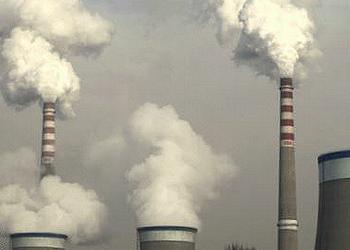
NAIROBI, Kenya, November 27, 2018 (ENS) – Global carbon dioxide (CO2) emissions rose again in 2017 after a three year pause, pinpointing the urgent need for countries to deliver on the Paris Agreement to keep global warming to 2°C above pre-industrial levels, finds a new report released today by the United Nations Environment Programme, UNEP.

UNEP’s 2018 Global Emissions Report, show global emissions have reached historic levels.
Total annual greenhouse gas emissions, including from land-use change, reached a record high of 53.5 gigatons in 2017, an increase of 0.7 compared with 2016.
“In contrast, global greenhouse gas emissions in 2030 need to be approximately 25 percent and 55 percent lower than in 2017 to put the world on a least-cost pathway to limiting global warming to 2°C and 1.5°C respectively,” says the report.
Some countries are trying to reduce their carbon emissions. In January 2017, China’s energy regulator ordered 11 provinces to stop over 100 coal-fired power projects, with a total installed capacity of more than 100 gigawatts, but the worldwide greenhouse gas emissions gap is still widening.
This ninth UNEP greenhouse gas emissions report was prepared by an international team of scientists, assessing all available information.
“When governments embrace fiscal policy measures to subsidize low-emission alternatives and tax fossil fuels, they can stimulate the right investments in the energy sector and significantly reduce carbon emissions,” said UNEP’s Chief Scientist Dr. Jian Liu.

“Thankfully, the potential of using fiscal policy as an incentive is increasingly recognized,” said Dr. Liu, referring to the 51 initiatives already in place or planned throughout the world to charge for carbon emissions, a policy called “carbon pricing.”
“If all fossil fuel subsidies were phased out, global carbon emissions could be reduced by up to 10 percent by 2030,” Dr. Liu added, explaining that “setting the right carbon price is also essential. At US$70 per ton of CO2, emission reductions of up to 40 percent are possible in some countries.”
The UNEP report comes just days before the annual UN climate change conference, COP 24, taking place in Katowice, Poland December 2-14. The key objective of COP24 will be to adopt an implementation plan for the 2015 Paris Agreement.
It follows after the release Friday of the U.S. government’s Fourth National Climate Assessment, congressionally mandated and developed by the U.S. Global Change Research Program, USGCRP, and 300 scientists in 13 federal agencies.
The USGCRP report concludes that the United States will warm at least three more degrees by 2100 unless the burning of fossil fuels is limited immediately.
The U.S. report connects climate change to increasing water scarcity and drought, worsening storms, deadly wildfires and greater exposure to tropical diseases across the United States.
“With continued growth in emissions at historic rates, annual losses in some economic sectors are projected to reach hundreds of billions of dollars by the end of the century – more than the current gross domestic product of many U.S. states,” finds the USGCRP report
The United Nations report follows shortly after the Intergovernmental Panel on Climate Change, IPCC, released a in October, which cautioned that emissions had to stop rising now, to keep temperature increases below 1.5°C, and reduce the risks for the well-being of the planet, its peoples and its wildlife.

“If the IPCC report represented a global fire alarm, this report is the arson investigation,” said UNEP’s Deputy Executive Director Joyce Msuya of Tanzania. “The science is clear; for all the ambitious climate action we’ve seen – governments need to move faster and with greater urgency. We’re feeding this fire while the means to extinguish it are within reach.”
There is no sign of reversal of this trend and only 57 countries, representing 60 percent of global emissions, are on track to bridge their “emissions gap” – the gap between where we are likely to be and where we need to be.
Increased emissions and lagging action means the gap published in this year’s report is larger than ever.
UNEP stresses that while “surging momentum from the private sector” and “untapped potential from innovation and green-financing” offer “pathways” to bridge the emissions gap globally, the “technical feasibility” of limiting global warming to 1.5°C “is dwindling.”
The authors of the report note that nations would need to triple their efforts on climate action without further delay, in order to meet the 2°C-rise limit by mid-century. To meet the 1.5°C limit, they would have to quintuple their efforts. A continuation of current trends will likely result in global warming of around 3°C by the end of the century, with continued temperature rises after that, according to the report findings.
“The kind of drastic, large-scale action we urgently need has yet to been seen,” said UNEP.
The report offers ways for governments to bridge their emissions gaps, through fiscal policy, innovative technology, non-state and subnational action, and more.
The 2018 Global Emissions Report report adds yet another building block of scientific evidence to inform decision-making at the upcoming UN climate change conference – the COP 24 in Poland – which starts on Sunday and will last for two weeks.
Copyright Environment News Service (ENS) 2018. All rights reserved.
© 2018, Environment News Service. All rights reserved. Content may be quoted only with proper attribution and a direct link to the original article. Full reproduction is prohibited.
